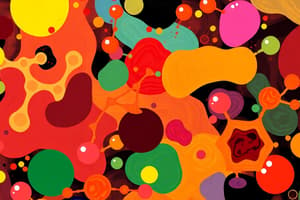Podcast
Questions and Answers
What is the main function of cation exchange in resin?
What is the main function of cation exchange in resin?
- To filter large molecules from a solution
- To remove anions from a solution
- To exchange cations for other cations in the resin (correct)
- To enhance the stability of proteins
Which method is primarily used for peptide sequencing?
Which method is primarily used for peptide sequencing?
- Edman Degradation (correct)
- X-ray diffraction
- Gel-filtration chromatography
- SDS treatment
How does size exclusion chromatography separate molecules?
How does size exclusion chromatography separate molecules?
- According to the size of the molecules and their ability to enter pores (correct)
- Based on their charge
- By their interaction with surface ions
- Using temperature variations in the solution
What role does SDS play in the electrophoresis of proteins?
What role does SDS play in the electrophoresis of proteins?
What technique is best for determining the tertiary and quaternary structure of proteins?
What technique is best for determining the tertiary and quaternary structure of proteins?
What is the primary structure of nucleic acids?
What is the primary structure of nucleic acids?
Which of the following correctly describes phosphoacylglycerols?
Which of the following correctly describes phosphoacylglycerols?
What distinguishes active transport from passive transport mechanisms?
What distinguishes active transport from passive transport mechanisms?
Which of the following types of membrane proteins is directly associated with the lipid bilayer?
Which of the following types of membrane proteins is directly associated with the lipid bilayer?
Which molecules are primarily involved in the secondary structure of nucleic acids?
Which molecules are primarily involved in the secondary structure of nucleic acids?
Which fatty acid is classified as saturated?
Which fatty acid is classified as saturated?
What is true about facilitated diffusion?
What is true about facilitated diffusion?
Which component is NOT a part of a nucleotide?
Which component is NOT a part of a nucleotide?
What is the role of the Na+/K+ ATPase pump?
What is the role of the Na+/K+ ATPase pump?
Which of the following is a characteristic of the fluid mosaic model?
Which of the following is a characteristic of the fluid mosaic model?
What is the primary characteristic of lipids in relation to water?
What is the primary characteristic of lipids in relation to water?
Which enzyme is specifically inactivated by DIPF through interaction with serine-195?
Which enzyme is specifically inactivated by DIPF through interaction with serine-195?
In the context of enzyme activity, what does phosphorylation specifically affect?
In the context of enzyme activity, what does phosphorylation specifically affect?
Which model describes the formation of an enzyme-substrate complex where both structures are complementary?
Which model describes the formation of an enzyme-substrate complex where both structures are complementary?
What defines an irreversible inhibitor in enzymatic reactions?
What defines an irreversible inhibitor in enzymatic reactions?
What is one role of coenzymes in enzymatic reactions?
What is one role of coenzymes in enzymatic reactions?
Which of the following statements correctly describes the induced-fit model?
Which of the following statements correctly describes the induced-fit model?
Which amino acids are primarily involved in general acid-base catalysis as acidic groups?
Which amino acids are primarily involved in general acid-base catalysis as acidic groups?
What characterizes the V system in allosteric enzymes?
What characterizes the V system in allosteric enzymes?
What is a common feature of passive transport mechanisms?
What is a common feature of passive transport mechanisms?
Flashcards are hidden until you start studying
Study Notes
Lipids
- A group of organic compounds insoluble in water, but soluble in organic solvents.
- Lipids can be amphipathic in nature, containing both hydrophilic and hydrophobic regions.
- Contain fatty acids, triacylglycerols, phosphoacylglycerols, and steroids.
Fatty Acids
- Unbranched-chain carboxylic acids containing a hydrocarbon chain.
- Saturated fatty acids lack C=C bonds and include palmitic acid and stearic acid.
- Unsaturated fatty acids contain C=C bonds and include oleic acid, linoleic acid, and arachidonic acid.
Triacylglycerol (Triglyceride)
- Esters of glycerol with three fatty acids.
Phosphoacylglycerols (Phospholipids)
- Glycerol's alcohol group is esterified by phosphoric acid.
Lipids Bilayers
- Composed of fatty acids with a polar surface containing charged groups.
- Hydrophobic tails are located within the interior of the bilayer.
Detergent
- Long tail and fewer double bonds.
- Short tails and a high abundance of double bonds result in a more flexible phospholipid.
Fluid Mosaic Model
- Describes membrane structure as fluid, allowing lateral motion of components in the membrane.
- Components exist as separate entities, including lipid bilayer, proteins, glycolipids, and steroids like cholesterol.
- There are no complexes; however, lipid-protein complexes can be formed.
Membrane Proteins
- Functions include transport of substances across the membrane, receptor sites, and enzyme catalysis.
- Held together by noncovalent interactions: ion-dipole, dipole-dipole, and loosely bonded.
- Membrane integral proteins (Group A) have nonpolar amino acids (methionine, phenylalanine, isoleucine, tryptophan, leucine, alanine).
- Anchored to the membrane by covalent bonding.
Concept of Gradient
- Membranes are selective barriers, acting as solvents and being osmotic.
- Molecules or ions move from a higher concentration gradient to a lower concentration gradient.
- Movement of water is called osmotic pressure.
Passive Transport
- Passive diffusion: a molecule or ion moves through an opening.
- Facilitated diffusion: a molecule or ion is carried across a membrane by a carrier/channel protein.
Active Transport
- Active transport: a substance is moved against a concentration gradient.
- Primary active transport: Transport linked to the hydrolysis of ATP or other high-energy molecules; for example, the Na+/K+ ion pump.
- Secondary active transport: Driven by an H+ gradient.
Nucleic Acids
- Biopolymers made of monomer units called nucleotides.
- Nucleotides contain a base derived from purine or pyrimidine, a monosaccharide (D-ribose or 2-deoxy-D-ribose), and phosphoric acid.
Pyrimidine/Purine Bases
- Pyrimidine: Cytosine (in DNA and RNA), Thymine (in DNA and some RNA), Uracil (only in RNA)
- Purine: Adenine (DNA and RNA), Guanine (DNA and RNA)
Nucleosides
- Compounds consisting of D-ribose or 2-deoxy-D-ribose covalently bonded to a nucleobase by a N-glycosidic bond.
- Examples include Cytidine (a ribonucleoside in RNA) and Deoxyguanosine (a deoxyribonucleoside in DNA).
1° Structure
- The order of bases on the polynucleotide sequence.
2° Structure
- The three-dimensional conformation of the polynucleotide backbone (double helix in DNA).
3° Structure
- Supercoiling (in prokaryotes).
4° Structure
- Interaction between DNA and proteins (histones in eukaryotes).
Ion Exchange Chromatography
- Resin has a negative charge and attracts and hold cations from the solution.
- Cations can be exchanged for other cations already bonded to the resin.
- Anion Exchange: Exchange between anions and cations.
Size Exclusion/Gel-filtration Chromatography
- Smaller molecules can enter pores of a stationary phase while larger molecules cannot.
- Larger molecules come out first, followed by smaller molecules.
Electrophoresis
- Charged molecules migrate in an electric field towards the opposite charge.
- The more negative the charge, the faster the molecule migrates.
- Proteins have different mobility based on charge and size (SDS treatment makes proteins smaller and negatively charged).
Primary Structure Determination
- Peptide Sequencing: Edman Degradation
Protein Cleavage
- Enzymes: Trypsin cleaves at the C-terminal of positively charged side chains; Chymotrypsin cleaves at the C-terminal of aromatic amino acids.
- Chemical reagents: Cyanogen bromide
Determination of Tertiary and Quaternary Structure
- X-ray and NMR data can determine the 3D structures of proteins.
- X-ray diffraction pattern is produced by electrons scattering X-rays.
Predicting Protein Folding
- Bioinformatics is used, and the first step is sequence homology (series of amino acids).
Enzyme Catalysis
- Enzymes are protein catalysts that lower the activation energy of a reaction.
- Examples include platinum surfaces and inorganic catalysts.
Catalytic Mechanism
- Found at the level of protein chain:
- General acid-base catalysis: donation and acceptance of protons
- Group C (acidic): Aspartic acid (Asp, D) and Glutamic acid (Glu, E)
- Group D (polar basic): Histidine (His, H), Arginine (Arg, R), and Lysine (Lys, K)
- Nucleophilic Substitution Catalysts: Nucleophilic electron-rich atom attacks electron-deficient atom.
- Group B (neutral polar): Serine (Ser, S), Cysteine (Cys, C), and tyrosine (Thr, T)
- Electrophilic Substitution Catalyst: Electrophilic electron-poor atom bonds an electron-deficient atom (metal ions).
- General acid-base catalysis: donation and acceptance of protons
Chymotrypsin
- Enzyme that acts as a catalyst for hydrolysis, breaking peptide bonds and increasing the rate of reaction.
- Targets peptide bonds at the C-terminal of aromatic side chains.
- Effect of DIPF: Inactivates chymotrypsin by reacting with serine-195C.
- Effect of TPCK: Reactive group that targets histidine 57.
Coenzymes
- Small molecules, coreactants, and non-protein substances that participate in an enzymatic reaction and are regenerated for further reaction.
- Metal ions can be used as coordination compounds (Zn2+, Fe2+).
- Vitamins can also serve as coenzymes (NADH or NADPH).
E-S Complex Formation
- Lock and key model: Complementary structures like a key fitting a lock.
- Induced-fit model: Less stable, undergoes a conformational change upon substrate binding to become complementary.
Michaelis-Menten Kinetics
- Describes the rate of enzymatic reactions as a function of substrate concentration.
Enzyme Inhibition
- Reversible Inhibitor: Binds to an enzyme to inhibit it, but the inhibition can be reversed.
- Irreversible Inhibitor: Causes inhibition that cannot be reversed.
Homotropic Effects
- Allosteric interactions that occur when direct substrates or products bind to the protein (e.g., Aspartate to ATCase).
Heterotropic Effects
- Allosteric interactions that occur when different substances bind to the protein (e.g., inhibitor of ATCase by CTP and activation by ATP).
Two Types of Allosteric Enzymes
- K System: An enzyme where an inhibitor or activator alters the K0.5 value.
- V System: An enzyme where an inhibitor or activator alters the Vmax value.
Control of Enzyme Activity via Phosphorylation
- Covalent phosphorylation of specific side chains at the primary structure level (ion-ion, ion-dipole, dipole-dipole interactions).
Studying That Suits You
Use AI to generate personalized quizzes and flashcards to suit your learning preferences.




